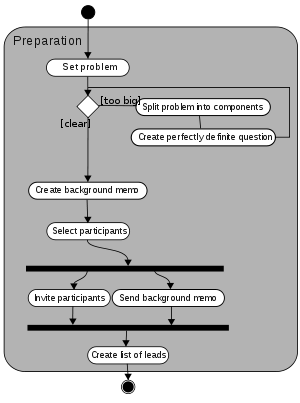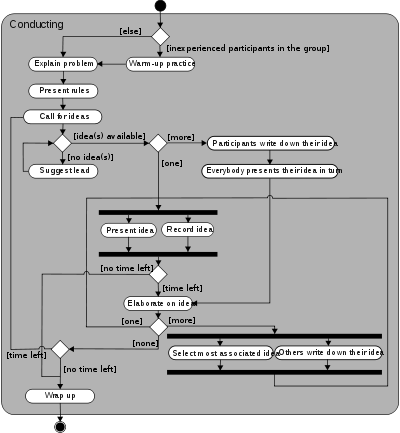Difference between revisions of "Brainstorming"
From Learning and training wiki
| Line 1: | Line 1: | ||
| − | {{Term|BRAINSTORMING|Group of creativity methods first popularized by A.F. Osborne in 1941, in which all member of a team are encouraged to generate and share ideas on a specific topic. The aim is to put the participants in the condition of creating original ideas and developing unusual approaches to a problem. Therefore, the group should feel free to express the ideas spontaneous just focusing on quantity, since every evaluation must be postponed later in the process. Following these ground rules in brainstorming can reduce the inhibitions in the group, including self-censorship, and enhance creative thinking: | + | {{Term|BRAINSTORMING|'''Group of creativity methods''' first popularized by A.F. Osborne in 1941, in which all member of a team are encouraged to generate and share ideas on a specific topic. The aim is to put the participants in the condition of creating original ideas and developing '''unusual approaches to a problem'''. Therefore, the group should feel free to express the ideas spontaneous just focusing on quantity, since every evaluation must be postponed later in the process. Following these ground rules in brainstorming can reduce the inhibitions in the group, including self-censorship, and enhance creative thinking: |
#'''Select a specific problem''', namely define the problem about which the brainstorming session should focus on. It must be a clear problem and, if too big, it should be broken into smaller parts, each one related to a question. Before the brainstorming session, it may be also useful to send the participants an invitation, containing a description of the problem, so they can start thinking about it; | #'''Select a specific problem''', namely define the problem about which the brainstorming session should focus on. It must be a clear problem and, if too big, it should be broken into smaller parts, each one related to a question. Before the brainstorming session, it may be also useful to send the participants an invitation, containing a description of the problem, so they can start thinking about it; | ||
#'''Select suitable participants''', ideally between six and twelve, as well non-experts as experts. It is important that they have a positive attitude towards brainstorming and an open way of thinking. Each member of the group should participate, since observers can inhibit the creative process; | #'''Select suitable participants''', ideally between six and twelve, as well non-experts as experts. It is important that they have a positive attitude towards brainstorming and an open way of thinking. Each member of the group should participate, since observers can inhibit the creative process; | ||
Revision as of 10:09, 27 May 2009
Group of creativity methods first popularized by A.F. Osborne in 1941, in which all member of a team are encouraged to generate and share ideas on a specific topic. The aim is to put the participants in the condition of creating original ideas and developing unusual approaches to a problem. Therefore, the group should feel free to express the ideas spontaneous just focusing on quantity, since every evaluation must be postponed later in the process. Following these ground rules in brainstorming can reduce the inhibitions in the group, including self-censorship, and enhance creative thinking:
Session conductTo lead a brainstorming session the facilitator usually follows these steps:
|

